



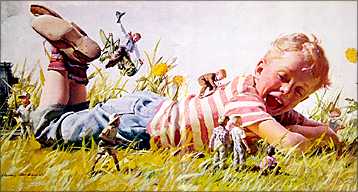
Harry Anderson's story is as unique as his ability. Born in 1906 in Chicago, he was going to be a mathematician. He started college at the University of Illinois in 1925. He took an art course as an easy counterpoint to the math classes and discovered both a talent and a love for drawing. From such simple choices our lives are made.
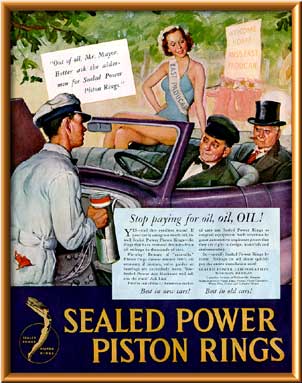 With the change in major came a change in venue. He moved to
Syracuse, New York, to attend the Syracuse School of Art in 1927.
It was a classical art education with the entire first year devoted
to drawing from the cast - a practice of presenting the student
with a bust or other piece of sculpture in various lightings and
having them render it in different media. It's a grueling technique
despised by most students for its repetitious boredom, but it
instills basic drawing skills that are crucial to an illustrator's
success. With the second year's classes came figure drawing and
anatomy classes as detailed as those for medical students. More
fundamentals that stood him in good stead his entire career.
With the change in major came a change in venue. He moved to
Syracuse, New York, to attend the Syracuse School of Art in 1927.
It was a classical art education with the entire first year devoted
to drawing from the cast - a practice of presenting the student
with a bust or other piece of sculpture in various lightings and
having them render it in different media. It's a grueling technique
despised by most students for its repetitious boredom, but it
instills basic drawing skills that are crucial to an illustrator's
success. With the second year's classes came figure drawing and
anatomy classes as detailed as those for medical students. More
fundamentals that stood him in good stead his entire career.
At Syracuse he met and roomed with Tom Lovell who became a lifelong friend and an important illustrator in his own right. They graduated with honors and moved to New York to share a studio and make their fortune. Unfortunately, this was 1931 and the Depression was in full force. It took Anderson over a year to make his first magazine sale and several more years before he felt established enough to move back home to Chicago.
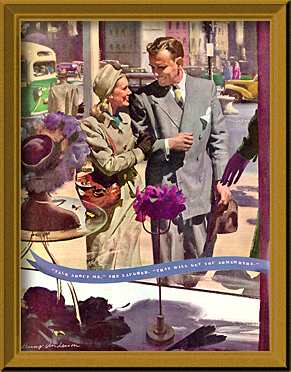 With
some New York magazine sales behind him, he joined an art service
agency that found work for its artists in return for a portion
of the fee. By 1937 he was working on national ad campaigns like
the one for Sealed Power Piston Rings in 1938 (above
right). He was also much in demand for story illustrations for
the major magazines. His work appeared in Collier's, Cosmopolitan,
Good Housekeeping, Ladies' Home Journal (image at
left from the August 1946 issue), Redbook, The Saturday
Evening Post and others. The images were on a par with the
best work being done at the time.
With
some New York magazine sales behind him, he joined an art service
agency that found work for its artists in return for a portion
of the fee. By 1937 he was working on national ad campaigns like
the one for Sealed Power Piston Rings in 1938 (above
right). He was also much in demand for story illustrations for
the major magazines. His work appeared in Collier's, Cosmopolitan,
Good Housekeeping, Ladies' Home Journal (image at
left from the August 1946 issue), Redbook, The Saturday
Evening Post and others. The images were on a par with the
best work being done at the time.
He married Ruth around 1940. She worked in the same building as Harry and posed for him on one occasion. The following year he left the agency and joined the studio of Haddon Sundblom - famous for his Coca-Cola Santa Claus paintings. He was too old for military service but he did contribute one poster to the war effort. The purchase of a home during this period led to a second fork in his career path.
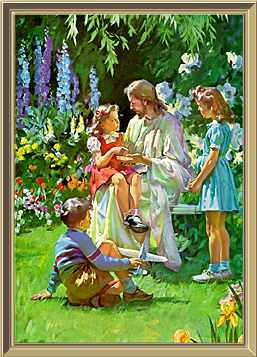 He
and Ruth joined the Seventh Day Adventist church and in 1944 Harry
was asked if he would contribute to their publishing efforts.
Harry generously said yes and the next year his most famous image
was crafted. "What Happened to Your Hand?"
(at right) was done for a children's book in 1945 and immediately
touched the hearts of that audience. The adults in charge of the
publishing program were less enthusiastic; some even considering
it near-blasphemous to show Christ in the present day. Cooler
heads prevailed and Anderson spent the rest of his active career
splitting his efforts between commercial assignments at his premium
wages and religious ones done for love and for scale.
He
and Ruth joined the Seventh Day Adventist church and in 1944 Harry
was asked if he would contribute to their publishing efforts.
Harry generously said yes and the next year his most famous image
was crafted. "What Happened to Your Hand?"
(at right) was done for a children's book in 1945 and immediately
touched the hearts of that audience. The adults in charge of the
publishing program were less enthusiastic; some even considering
it near-blasphemous to show Christ in the present day. Cooler
heads prevailed and Anderson spent the rest of his active career
splitting his efforts between commercial assignments at his premium
wages and religious ones done for love and for scale.
His art director at Review and Herald Publishing was T.K. Martin and it was his vision of Christ as a tangible presence in modern times that was shared and executed over and over again by Anderson. The inner peace that allowed Anderson to make his choice to contribute his time and effort at virtually minimum wage was evident in his paintings and in his depiction of Jesus.
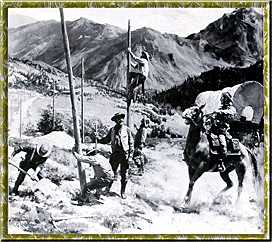 Actually,
that's unfair to Harry. That dedication and calm is present in
all of his work. As an important and popular illustrator,
he's almost unique in the gentleness of his images. Quite capable
of depicting nearly anything (see the western scene at right),
his choice of assignments and his approach to them was always
in line with the dictates of his heart. Not many people can live
their lives the way they want to. It seems that Anderson
did. He enjoyed the same quiet, focused strength in his private
life that's evident in his art.
Actually,
that's unfair to Harry. That dedication and calm is present in
all of his work. As an important and popular illustrator,
he's almost unique in the gentleness of his images. Quite capable
of depicting nearly anything (see the western scene at right),
his choice of assignments and his approach to them was always
in line with the dictates of his heart. Not many people can live
their lives the way they want to. It seems that Anderson
did. He enjoyed the same quiet, focused strength in his private
life that's evident in his art.
He was featured in a 1956 issue of American Artist and received awards from several art associations throughout his career including the prestigious New York Art Directors Club. In 1994 he was inducted into the Society of Illustrators' Hall of Fame.
In the Sixties he began painting calendars for Exxon Oil company (then Esso) and was able to stretch his artistic muscles on images based on "Great Moments in American History" and "Great Moments in Early American Motoring." Interestingly enough, Anderson was actively supporting himself with illustration work at a time when most of his generation was in forced retirement. Norman Rockwell is the only other illustrator I can think of who was still working and, I don't think coincidentally, also was one of the very few who took a moral stance with his work and maintained it throughout his career.
In the mid-Sixties, he expanded his religious horizons to include the Mormon Church, for whom he created a mural for the 1964 New York World's Fair. It was done in oil paints which he'd abandoned early is his career due to allergies to turpentine. New thinner products allowed him to explore the medium again. He produced a dozen more oil paintings for the Mormons, many of which have been reproduced in one of their publications entitled the Family Home Evening.
 In
1976, Review and Herald Publishing released Harry Anderson, The Man Behind
the Paintings, from which much of this essay is taken. The
picture one gets from reading it is that of a man of conviction
and great talent who was aware of both and didn't feel the need
to discuss either. His talents weren't limited to painting as
he crafted models of ships and buggies, hooked rugs, carved flocks
of birds, made furniture, and enjoyed many other dexterous skills.
He sounded like a very interesting person.
In
1976, Review and Herald Publishing released Harry Anderson, The Man Behind
the Paintings, from which much of this essay is taken. The
picture one gets from reading it is that of a man of conviction
and great talent who was aware of both and didn't feel the need
to discuss either. His talents weren't limited to painting as
he crafted models of ships and buggies, hooked rugs, carved flocks
of birds, made furniture, and enjoyed many other dexterous skills.
He sounded like a very interesting person.
He died in 1996 at the age of 90, the last of a generation
of illustrators from The Golden Age of magazine illustration.
It's almost certain that he was one of the last active
members of that group. His work is still being circulated, and
appreciated, today, in publications like Your Bible and You
and The Desire of Ages. It would be nice if they could
issue a reprint of the book about him at left.

To learn more about Harry Anderson, see:
| Harry Anderson, The Man Behind the Paintings | Raymond H. Woolsey and Ruth Anderson, 1976 Review and Herald |
| The Illustrator in America 1880 to 1980 | Walt and Roger Reed, 1984 Madison Square Press |
| Illustrators 36 | Fred Taraba's Hall of Fame essay, 1994 Watson-Guptill |
| The Vadeboncoeur Collection of Knowledge | Jim Vadeboncoeur, Jr. 1998 |
|
Illustrations are copyright by their
respective owners. This page written, designed & © 1998 by Jim Vadeboncoeur, Jr. Updated 2011. |
